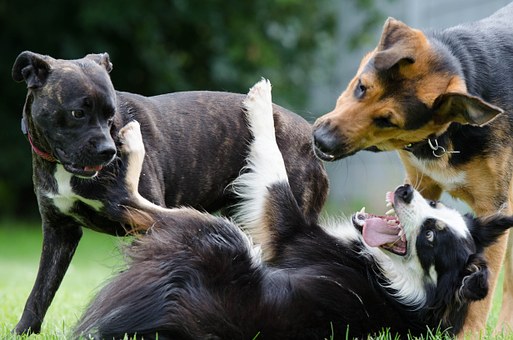As a dog owner, the thought of leaving your pup behind as you leave home isn’t too exciting, especially if you have an aggressive dog. The constant worry that your dog will bite or injure someone or someone else’s dog can be overwhelming.
However, life happens. You will need to go on a romantic vacation with your mate, travel overseas for work or business meetings, or go to the hospital for a few days.
In such instances, most dog owners opt to ask a neighbor or relative to ‘dog-sit’ their dogs but if you don’t have the luxury, dog boarding is a good option for you.
While boarding an aggressive dog has its fair share of challenges, especially if you are doing for the first time, it can be done smoothly and effectively if you know what to do. As a guide, we will highlight some of the fundamental things you should do to ensure that dog boarding for aggressive dogs are safe and effective.
Let’s dive in…

- What Is Dog Boarding?
- Common Dog Boarding Services
- Factor to Consider Before Choosing a Good Board Boarding Facility
- Tips To Make Dog Boarding Easier
- Tips To Ensure Great Dog Boarding Experience
- How to Prepare Your Dog for Boarding
- Should You Tip For Dog Boarding?
- What’s In Home-Dog Boarding?
- Pet Sitting In Your Home: When Does It Make More Sense?
- Dog Boarding Checklist
What Is Dog Boarding?
Dog boarding is a service offered by certain dog facilities and veterinarians, where dog owners can drop off their furry friends for some time for a fee.
At the boarding facility, dogs are fed, walked, and generally taken care of until the owner comes back from their trip. Often, dogs are kept in kennels in pet boarding facilities. These kennels are created in a way that ensures a dog feels safe and secure despite being away from home.
If your dog isn’t trained to stay enclosed in a small space, he can be kept in a large room with others.
Common Dog Boarding Services
A dog boarding facility will offer regular feeding, an enclosed run, grooming, watering, exercise, and close monitoring for any medical emergencies. Some pet boarding facilities even have luxurious services such as massages and dog training.
Ideally, the facility should have spacious play yards to give plenty of room for the dogs to run around. It should also have live webcams to keep tabs with all the canines.
Additionally, the counselors employed in the facility should be First Aid and CPR-trained and should be able to give the dogs lots of TLC.
Related Post: 10 Best Dog First Aid Kits for Hunting & Camping
Here are some of the most common types of dog boarding options you will come across today:
- Free-Range Kennels: Offers open spaces where dogs can play freely with one another all day until bedtime. Typically, a dog’s day includes individual feeding, morning and afternoon playtime, individual attention for dogs with special needs, naptime, and bedtime in individual rooms. It is the most common type of dog boarding and allows your dog to play and interact with new canine friends while also remaining safe and secure.
- In-Home Boarding: Entails choosing a reregistered dog sitter who cares for your dog in his or her home when you are away. We’ll discuss more about it later.
- Dog Sitter: Here, you arrange for a licensed dog sitter to stay in your home and take care of your dog when you are away.
- Veterinary Facilities: This entails leaving your dog in the care of professional caretakers for the duration that you are away. One of the top benefits of this type of boarding is the fact that your dog is left in the hands of the most qualified professionals who are equipped for any kind of emergency and specialized care. It is the best option to go for if you need your dog to be observed closely or if he requires frequent medical attention.
- Dog Hotels: In dog hotels, your dog is offered a wide range of luxurious perks besides general care. Some of the perks that your dog is likely to enjoy in a dog hotel include blueberry facials, beach excursions, aromatherapy, and being driven or collected in luxurious cars such as Rolls Royce and Lamborghini among other royalty treatments.
Factor to Consider Before Choosing a Good Board Boarding Facility for an Aggressive Dog

Like any other service out there, not all pet boarding facilities are equipped to provide excellent boarding for aggressive dogs. Some are just not worth your time and consideration, let alone your hard-earned money.
But how would you know the perfect fit for you? Here are a few things to consider:
- The Basics (meals, exercise times, baths): First and foremost, you need to find out the facility’s ability to actually give your dog the basic requirements. What’s the feeding schedule? How does the facility store dog food? When in a new environment, dogs tend to have stomach upsets and diarrhea. Only settle for a facility with high standards when it comes to food handling. What about the bath schedule? Does the facility have a solid exercise schedule for all dogs?
- Daily Dog Routine: It isn’t just enough to feed, walk, and groom your dog. A good dog boarding facility for aggressive dogs should tell you what your dog will be up to all day long when you are away. Ask the facility what they intend to do to keep your furry friend engaged all day. They should be able to give you a straight-up and detailed response that satisfies you. If not, take a walk.
- Well Trained Staff: Like humans, dogs run into emergencies from time to time. For this reason, you might want to choose a facility with an available, trained staff member at any time of day and night. Avoid those that leave your dog unattended for hours. A veterinary facility is highly recommended for an aggressive dog. This is because you can always rest easy knowing that the people handling your dog are experts—and should your dog’s behavior go off-limits to an extent that sedation is necessary, the facility and the staff can do so safely without any issue.
- Overall Environment: Changing your dog’s environment is hard enough for your pup. You should at least settle for the best dog facility that will make him as comfortable as possible. Visit as many facilities as possible before you settle on one. While you are at it, check out where your pet will sleep, eat, and play. Take note of the cleanliness of the space. Ensure it is a stable environment where your dog will meet and socialize with other dogs.
- Stress-Management Strategies: Human beings aren’t the only creatures that suffer from stress. Four-legged creatures, particularly dogs, do too. This is why it is a good idea to look for a pet boarding that can handle a dog that exhibits aggressive behaviors or signs of stress from time to time. Common stress management strategies include regular walks and pheromone collars. The facility should also have a staff on standby to take care of your furry friend when they are stressed.
- Vaccination Policies: Pets are more likely to fall sick when they visit a boarding facility than when they are at home. For this reason, most pet boarding facilities have strict vaccination policies in place. Some of the important vaccinations include Bordetella and rabies vaccinations. Consider asking for proof of vaccination before settling for a given facility.
- Insurance: Since an aggressive dog can attack other dogs or people, opt for a boarding facility with an insurance policy that can cover your dog in case of an emergency. Many dog boarding or sitting facilities have liability insurance policies that only cover themselves and their staff but seldom cover guest dogs. Avoid such facilities; instead, choose facilities that offer premium insurance to guest dogs as well.
How to Prepare Your Dog for Boarding
A few days before you leave your dog behind, you may want to adequately prepare him for what is about to happen.
- Spend quality time with the dog: The time you spend with your dog matters to him more than you’ll ever know. Before you leave, be sure to log in more time with him snuggling, cuddling, doing lap time, and walking.
- Introduce your dog with the pet sitter beforehand: Secondly, you might want to allow your pup to meet his handler before you drop him off. This will help him feel a little comfortable with the otherwise stranger.
- Exercise before packing up: This might come as a shock to you but exercising your dog just before you leave can make or break his boarding experience. Simply take a walk or play fetch with your pet to help him expend some energy and feel more relaxed through the new phase.
- Stay calm throughout the separation process: Dogs are intelligent beings who can decipher human emotions. If you are feeling a little emotional when leaving him, he will likely feel the same way. Try to stay as comfortable as you can to inspire the same on his side.
Tips to Ensure Great Boarding Experience for your Aggressive Dog

You’ve spent days looking for the perfect pet boarding facility and have finally landed on the best one. As you prepare to drop off your four-legged friend, you can’t help but wonder what to do to make it a good experience for him.
Well, we’ve got you covered. Here are some genius tips.
- Be detailed about your dog’s behaviors: Aggression behaviors in dogs can be handled when they are expected. So, always strive to provide as much details about your dog’s behavior as possible. Let the boarding facility know things that trigger your dog’s aggressive behavior. Does he display the behavior when you surprise him or raise your voice at him? Besides, let the staff know the times when your dog is likely to show aggression. Is he more aggressive in the morning when you want to feed him or in the evening when he is tired? Providing detailed information about your dog’s behavior will give the boarding facility’s staff a better idea of how to handle your canine companion without inciting aggression.
- Bring The Right Gear: If your dog needs to be muzzled at certain times to control his behaviors, ensure that you bring his muzzle to the boarding facility. Bring a shock collar and other relevant training devices that he uses too, and give the boarding facility’s management an idea of how to use the devices effectively on your dog. And don’t forget to include a number of your dog’s favorite toys to keep him busy while you are away. You can also bring a blanket or soft towel with your scent in it to make your dog feel at home.
Here Are Some Great Toys Your Aggressive Dog May Like:
15 Best Dog Toys You Can Put Peanut Butter in
10 Best Heartbeat Dog Toys
8 Best Chew Guard Technology Dog Toys
- Pack the Right Food and Medication: Besides the right gear, don’t forget to bring food and medication that your dog may not access in the boarding facility. This way, you don’t have to worry about diet changes that might wreak havoc on his digestive system or having him skip his meds.
- Ensure your canine is up-to-date on all his tick and flea preventatives. This requires a thorough medical exam with blood work if it has been a while since the last exam.
- Give the facility a list of emergency contacts in case of emergencies: If you have a friend or relative who is familiar with your pup, consider leaving their contacts with the boarding facility. This way, when your dog becomes uncontrollable or if there’s an emergency when you are away, there is someone that the facility can call to take the necessary steps.
- Book the reservation in advance and tour the place before taking your dog. Ensure that the facility is equipped with all the supplies you feel will make your dog’s stay comfortable. If a pet sitter is coming to your home (for instance, in-home boarding arrangement, which we’ll discuss shortly), let them know how things run in your home. For instance, let them know the type of lights your dog prefers, where the heater or conditioner is and whether they can touch foods and drinks in your house, etc.
- Ask for proof of life updates: Consider asking the boarding facility staff to send you photos and texts of how your dog is doing from time to time. If a pet sitter is coming to your home, ask him to do the same. For convenience, invest in suitable dog cam and let the pet sitter know that you have one.
Should You Tip For Dog Boarding?

You pay handsomely to have someone watch over your pet when you are away. Unless you are feeling extra generous, tipping isn’t really expected. The rule of thumb is, if you do tip your pet sitter, give 15-20% of the agreed rate, in cash.
Having said that, there are special circumstances when tipping your dog handler is a good idea, including:
- If your dog is aggressive or difficult.
- If the pet sitter took on the job at the 11th hour.
- Your dog required medication that they usually don’t need.
- If the dog sitter went off their way to offer extra services to your dog.
What’s in Home-Dog Boarding?
If you aren’t too sure about transporting your dog to a pet boarding facility for whatever reason, you can consider in-home pet boarding.
Basically, this involves having your dog taken care of in an expert handler’s home rather than a boarding facility.
Begin your search by looking through a registered home near you. This is a 24-hour service where your pet will be taken care of by a trusted and certified professional for an agreed fee.
There are plenty of free-to-browse in-home boarding sites that do thorough background checks on dog hosts to ensure they are qualified to watch over your dog. When you find a host that is a match, you can take your dog over to their house for an agreed time and rate.
In-home boarding encourages individual attention and regular walks. Your dog will also socialize with other dogs in the household and enjoy regular feeding and exercise schedules.
Pro Tip:
Like a boarding facility, ensure that the in-home boarding provider can handle aggressive dogs. If possible, conduct an in-home consultation with the provider before leaving your dog with him to ensure that everyone is comfortable. Remember to disclose your dog’s aggressive behavior and any other relevant information about your dog so that the provider knows what to expect.
Pet Sitting in Your Home: When Does It Make More Sense?
Pet sitting and pet boarding are both popular methods dog owners utilize when in need of someone to watch over their dogs in their absence. With pet sitting, a dog handler will come to your home to watch over your pooch for some time.
The advantages of pet sitting include individual attention and more comfort. Your pet doesn’t need to adjust to a new environment and it is, therefore, less likely to catch a disease.
The cons of pet sitting include high prices. Personalized services are obviously expensive. Sometimes, an aggressive dog may also find it hard to accept a new face. But again, this is a challenge with pet boarding.
So, if you are looking for personalized care for your furbaby or think he’s too aggressive for a pet boarding environment, consider pet sitting.
Dog Boarding For Aggressive Dogs Checklist

Before you send your dog to a foreign place (whether he is aggressive or not), make sure you pack his bag right. The following items are a must no matter the boarding facility you are dropping him off to:
- Vaccine records: Ensure your pup is in touch on all his vaccinations (parvo/distemper, rabies, and Bordetella).
- Food: Pack enough food (plus detailed feeding instructions) to last him the days in the boarding facility… and more.
- Home comforts: Include a dog bed, favorite toys, blanket, and a piece of cloth with your smell.
- Medication: If your dog is using some medication, be sure to pack it.
- Collar and ID tags: To avoid your dog missing, pack his collar and ID tags
- Contact info: Last but not least, add three emergency contacts for someone nearby
The Bottom Line
Dog boarding is a great option when looking for someone to watch your dog while you are away from home. And many dog boarding facilities are ready to take aggressive dogs as long as you can supply them with enough information about your dog and follow some of the recommendations on this post. The most important thing is to choose the right dog boarding facility with the right staff and equipment to handle different types of dogs, including aggressive ones. Follow the tips here and ensure your dog gets the best when you are aren’t around.
Related Posts:
Why Does My Dog Bite Me When Excited?
Why Is My Dog Aggressive Towards Me But Not My Husband?
As an Amazon Associate, we may receive a small commission from qualifying purchases but at no extra cost to you. Learn more. Amazon and the Amazon logo are trademarks of Amazon.com, Inc, or its affiliates.

